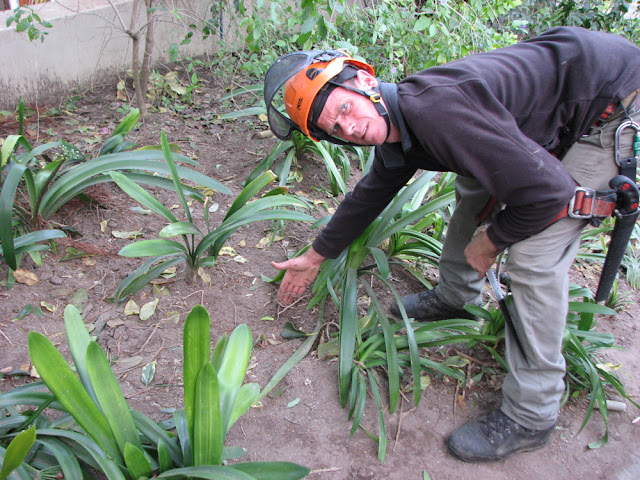 |
| Large tree pruning can require difficult climbing and the use of special equipment. |
Trees are pruned for one reason only: In our urban space
we either appreciate or dislike them for the way they either improve or spoil
the quality of our living space. Wild trees found in nature are inhabited by
many subsistence organisms due to the moribund nature of plant growth, because dead
or dying plant material offer highly attractive building materials for animals,
insects and micro-life such as fungi and bacteria. In turn, these are necessary
for other life-cycles, all responsible for the well-being and balance of life on
planet Earth.
 |
| Half way... |
When we decide to prune "our" trees, it is for the
following reasons: The removal of diseased or storm-damaged branches, to thin
the crown for better light and air circulation, to reducing the height and
width of the tree, for the removal of obstructive lower branches, and to shape
a tree for design purposes.
It is an intricate art to create a balanced crown in
which all branches are the same age or thickness at every level within the
canopy.
"A serious custodian or property owner will seek the
services of an experienced arborist," says Charles. “Large tree pruning in
particular can require difficult climbing and the use of special equipment, a
job which should be left to a trained and experienced professional.
"Owners are often impatient about getting their trees
pruned, not realising that the job requires a very careful approach and can be
time-consuming. The results are always overwhelming and well worth the wait."
 |
| Done. The results are always overwhelming and well worth the wait. |
***
Don't farm your garden..!
Roots
exposed due to unnecessary 'skoffeling'. Garden services often don’t understand
horticultural practices and end up 'farming' in the garden.
 An inspection of the tree and information about its history has revealed that the paving is about 30 years old; there is a
possibility that periodic application of a herbicide did take place and that
the French drain had been diverted with the modernisation of kitchens and
bathrooms.
An inspection of the tree and information about its history has revealed that the paving is about 30 years old; there is a
possibility that periodic application of a herbicide did take place and that
the French drain had been diverted with the modernisation of kitchens and
bathrooms.













